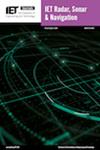Using lightweight denoising network to suppress multiple barrage jamming in range-Doppler domain
Abstract
Barrage jamming technology poses a significant threat to radar detection functions, yet there is limited research on anti-multiple barrage jamming using single-channel radar systems. Addressing this gap, this paper proposes a framework for anti-multiple barrage jamming based on range-Doppler domain denoising. This framework first performs pulse compression and Doppler processing on the echo signal to enhance the signal-to-jamming ratio. The range-Doppler spectrum data is then input into a deep denoising network to suppress multiple types of jamming. Additionally, the paper proposes a lightweight deep denoising network comprising a feature extraction module, a jamming suppression module, and a feature fusion module. The feature extraction module preliminarily extracts jamming features using multiple layers of depth-wise and point-wise convolution. The jamming suppression module removes noise at various resolutions through a lightweight encoding and decoding structure, effectively suppressing the barrage jamming signal. The feature fusion module uses convolution kernels with different sizes to merge the multiple features output by the jamming suppression module. Simulation results demonstrate that the proposed method effectively suppresses ten types of barrage jamming. Furthermore, a measured dataset is constructed to verify the method’s effectiveness.


 求助内容:
求助内容: 应助结果提醒方式:
应助结果提醒方式:


